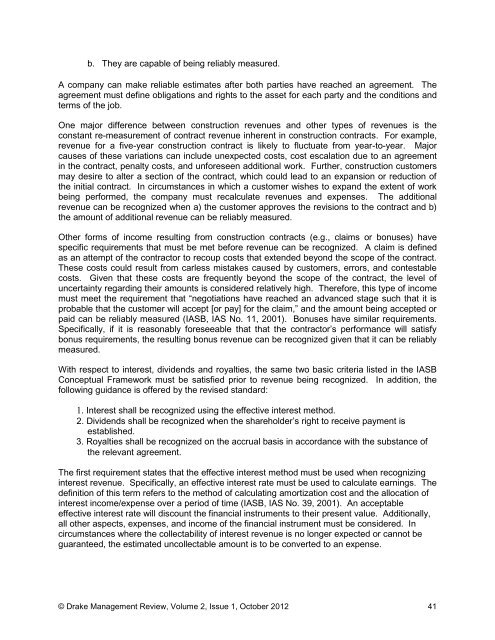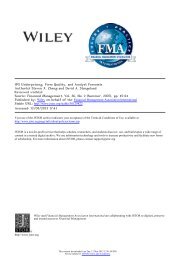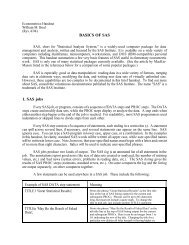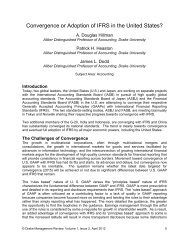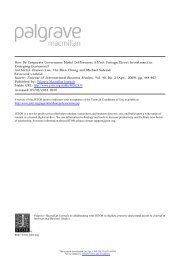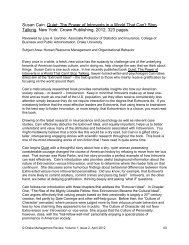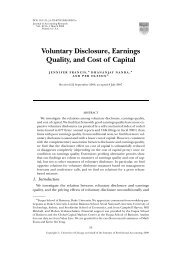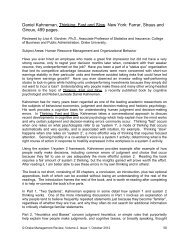IASB & FASB Convergence Project - Drake College of Business and ...
IASB & FASB Convergence Project - Drake College of Business and ...
IASB & FASB Convergence Project - Drake College of Business and ...
Create successful ePaper yourself
Turn your PDF publications into a flip-book with our unique Google optimized e-Paper software.
. They are capable <strong>of</strong> being reliably measured.A company can make reliable estimates after both parties have reached an agreement. Theagreement must define obligations <strong>and</strong> rights to the asset for each party <strong>and</strong> the conditions <strong>and</strong>terms <strong>of</strong> the job.One major difference between construction revenues <strong>and</strong> other types <strong>of</strong> revenues is theconstant re-measurement <strong>of</strong> contract revenue inherent in construction contracts. For example,revenue for a five-year construction contract is likely to fluctuate from year-to-year. Majorcauses <strong>of</strong> these variations can include unexpected costs, cost escalation due to an agreementin the contract, penalty costs, <strong>and</strong> unforeseen additional work. Further, construction customersmay desire to alter a section <strong>of</strong> the contract, which could lead to an expansion or reduction <strong>of</strong>the initial contract. In circumstances in which a customer wishes to exp<strong>and</strong> the extent <strong>of</strong> workbeing performed, the company must recalculate revenues <strong>and</strong> expenses. The additionalrevenue can be recognized when a) the customer approves the revisions to the contract <strong>and</strong> b)the amount <strong>of</strong> additional revenue can be reliably measured.Other forms <strong>of</strong> income resulting from construction contracts (e.g., claims or bonuses) havespecific requirements that must be met before revenue can be recognized. A claim is definedas an attempt <strong>of</strong> the contractor to recoup costs that extended beyond the scope <strong>of</strong> the contract.These costs could result from carless mistakes caused by customers, errors, <strong>and</strong> contestablecosts. Given that these costs are frequently beyond the scope <strong>of</strong> the contract, the level <strong>of</strong>uncertainty regarding their amounts is considered relatively high. Therefore, this type <strong>of</strong> incomemust meet the requirement that “negotiations have reached an advanced stage such that it isprobable that the customer will accept [or pay] for the claim,” <strong>and</strong> the amount being accepted orpaid can be reliably measured (<strong>IASB</strong>, IAS No. 11, 2001). Bonuses have similar requirements.Specifically, if it is reasonably foreseeable that that the contractor’s performance will satisfybonus requirements, the resulting bonus revenue can be recognized given that it can be reliablymeasured.With respect to interest, dividends <strong>and</strong> royalties, the same two basic criteria listed in the <strong>IASB</strong>Conceptual Framework must be satisfied prior to revenue being recognized. In addition, thefollowing guidance is <strong>of</strong>fered by the revised st<strong>and</strong>ard:1. Interest shall be recognized using the effective interest method.2. Dividends shall be recognized when the shareholder’s right to receive payment isestablished.3. Royalties shall be recognized on the accrual basis in accordance with the substance <strong>of</strong>the relevant agreement.The first requirement states that the effective interest method must be used when recognizinginterest revenue. Specifically, an effective interest rate must be used to calculate earnings. Thedefinition <strong>of</strong> this term refers to the method <strong>of</strong> calculating amortization cost <strong>and</strong> the allocation <strong>of</strong>interest income/expense over a period <strong>of</strong> time (<strong>IASB</strong>, IAS No. 39, 2001). An acceptableeffective interest rate will discount the financial instruments to their present value. Additionally,all other aspects, expenses, <strong>and</strong> income <strong>of</strong> the financial instrument must be considered. Incircumstances where the collectability <strong>of</strong> interest revenue is no longer expected or cannot beguaranteed, the estimated uncollectable amount is to be converted to an expense.© <strong>Drake</strong> Management Review, Volume 2, Issue 1, October 2012 41


